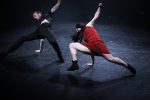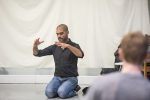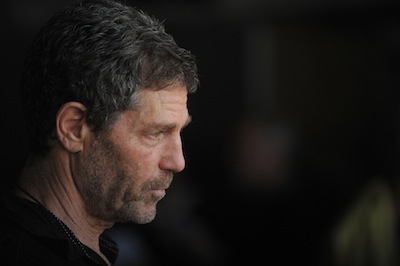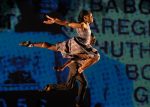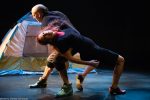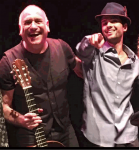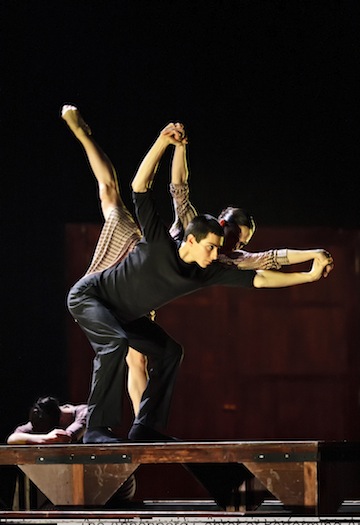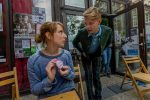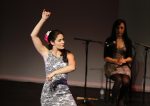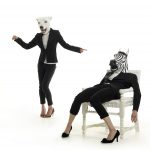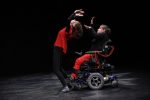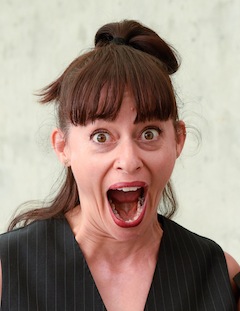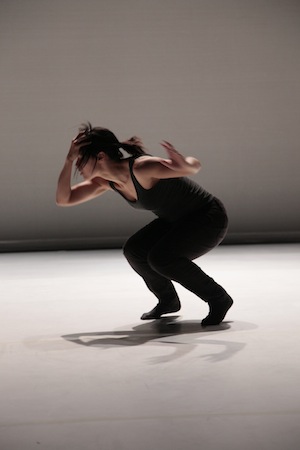Chuck Wilt and Rebecca Margolick in birds sing a pretty song. (photo by Maxx Berkowitz)
Social media has changed the way in which we work, play and shop. It has changed how we communicate, access information, and even how we define ourselves.
A new work by Rebecca Margolick and Maxx Berkowitz, called birds sing a pretty song, “explores how surveillance and confinement through our digital and physical surroundings affect one’s sense of reality and self.” The full-length piece will have its world premiére in New York City next week. It will then arrive in Vancouver for its Canadian première at Chutzpah!Plus May 13-14.
Birds sing a pretty song was created during a year-long fellowship at New York’s 14th Street Y Theatre’s LABA: A Laboratory for Jewish Culture and two Chutzpah! Festival creation residencies.
LABA describes itself as a program “that uses classic Jewish texts to inspire the creation of art, dialogue and study.”
“After learning about LABA in 2015, we decided to take our shared vision and esthetic to create a piece together that would leverage our differing backgrounds and skill sets of dance and music, design and tech,” said Margolick and Berkowitz in an email interview. “Through the year of study and support from the LABA fellowship, our original concept, revolving around the loss of physical self in a hyper-social world, evolved through the varied conversations about beauty and imagery seeded by the provocative ideas in the ancient texts we studied.
“We had two work-in-progress showings at the 14th Street Y in April 2016 and, this past year, we were fortunate to be able to continue to develop the full-length piece through the support of two creation residencies from the Chutzpah! Festival, in Vancouver and Sointula, B.C., where we refined the choreography and brought in live music. The roots of last year’s showing are still present; however, the movement, sound and film have all changed.”
“Some of the most memorable moments in the development of the piece were when Maxx and I would have moments of clarity between us,” said Margolick. “After coming up with complex ideas, we would realize that staying true to our core goal for this piece, being that simple and raw, can be the most impactful, and that technology should be used as a means to enhance the narrative of the work, rather than a means of distraction or excess.”
As for Berkowitz, he said, “One of the most memorable conversations Rebecca and I had during the development of this piece was walking home after a LABA study session where we had read the story of a rabbi who was known as one of the most beautiful people of the time. His beauty led a princess who loved him without reciprocation … to the point of losing touch with what his beauty meant to her, coveting his beauty to the point of taking the skin off of his face to make a mask for herself. This horrifying story led us to discuss the parallels with how one can lose themselves in their online personas, seeking fame, beauty and recognition to the point of losing their sense of self.”
Birds sing a pretty song involves two dancers, whose wanderings the audience follows “through a world manipulated and influenced by the ‘curators’ … and projected light structures that move and direct the world onstage. Throughout the piece, they encounter an attempt at a relationship, fleeting glimpses of memory, and a fight for connection.”
Dancers Margolick and Chuck Wilt are joined by guitarist/media/composer Berkowitz, guitarist/composer Jake Klar and percussionist Bruno Esrubilsky (the curators) and Israeli author and scholar Ruby Namdar.
“The idea of ‘curators’ came from our exploration of how, in our social media platforms, it is easy to forget that everything you see is carefully selected for you based on the computer-crafted picture of you, that you can get trapped in a sounding room where the news, information and even advertising is targeted at your historical tastes and how that can be harnessed to manipulate your choices and decisions and fixes you into a stereotype of yourself,” explained Berkowitz. “This has become even more [relevant] in the current political climate and the ‘post-truth’ world, in which social media has played such a heavy role, and surveillance is an ever-increasing fact of life.”
“We wanted to play with the idea of the dancers being trapped in a curated space (the stage), where the musicians subtly manipulate the dancers’ movement and reactions,” added Margolick. “The dancers are also aware of the audience’s gaze, subconsciously at first but, as the piece goes on, they become aware of the audience and curators and are left exposed.
“As a performer, I was always intrigued by the fact that you’re in an enclosed space together with the audience, where you are aware that the audience is watching you as you are also watching them. This feeling of being observed while also observing is something I wanted to explore in this piece.”
Margolick has family connections in Vancouver, and has given of her time to the Jewish Community Centre of Greater Vancouver’s Festival Ha’Rikud, which she will do again when she is here in May. She also has connections to the Metro Vancouver dance community.
“I trained at Arts Umbrella from 6 to 18 years old and, through that program, I was introduced to both local and international dance artists and choreographers,” she said. “Over the past couple years, I’ve traveled between New York City and Vancouver and have been involved in dance projects with Donald Sales’ Project20 and Shay Kuebler’s Radical System Art. As for the Jewish community, through growing up attending Temple Sholom, working at the JCC summer day camp and dancing with Or Chadash, I was immersed into the local Jewish community.”
Berkowitz, too, has local ties.
“I was fortunate,” he said, “to be involved with the Chutzpah! Festival in the past, joining Shay Kuebler’s Radical System Art’s residency in Sointula to document their process and teach photography to local residents. And, in 2015, my up-and-coming band Twin Wave had two performances in Vancouver, at the Imperial Theatre and the Red Room.”
Among the major supporters of birds sing a pretty song are the Jewish Foundation of Greater Vancouver, Phyliss and Irving Snider Foundation, Diamond Foundation, Betty Averbach Foundation, Canada Council for the Arts, B.C. Arts Council and the City of Vancouver.
Birds sing a pretty song is at the Rothstein Theatre May 13, 8 p.m., and May 14, 7:30 p.m. Tickets are $29.50, $25.50 (senior) and $23.50 (student) and can be purchased at chutzpahfestival.com, 604-257-5145 or in-person at the JCCGV, as well as from Tickets Tonight, 604-684-2787.

